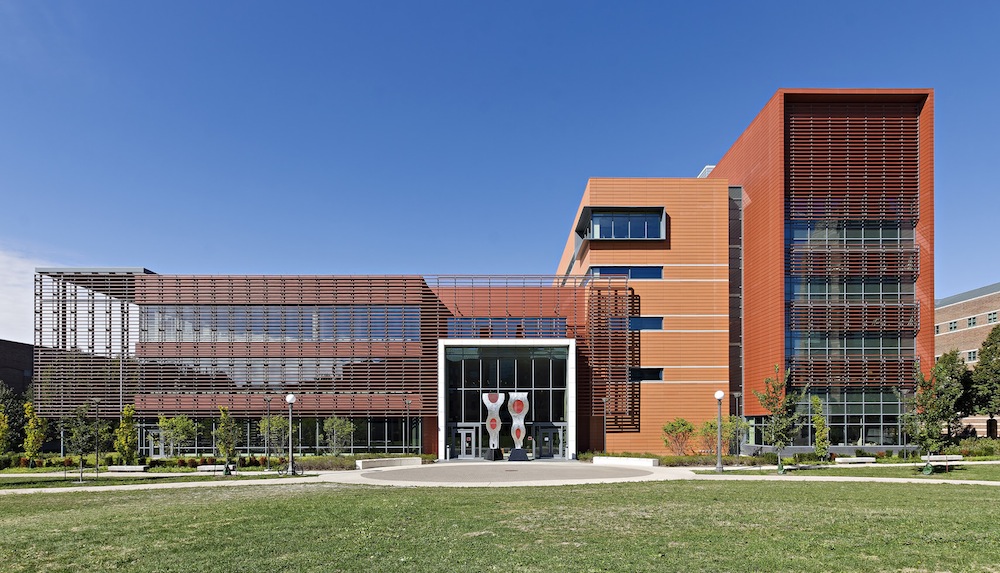The University of Illinois’s new Electrical and Computer Engineering Building has been named R&D Magazine’s 2016 Laboratory of the Year.
SmithGroupJJR designed the $95 million, 230,000-sf research facility. Located on the school’s Urbana campus, the ECE Building contains the Department of Electrical and Computer Engineering (ECE Illinois), which is known for its research in transistors, integrated circuits, LEDs and plasma displays.
The award, in its 50th year, honors new and renovated labs that promote sustainable practices and creativity in the design of modern laboratories.
The designers stressed energy efficiency. The building uses 50% less energy than minimum building energy efficiency standards, and it is targeting a LEED Platinum certification. Some of the sustainable feature include high-performance LED lighting, heat recovery chillers with net metering, and a chilled beam cooling system.
A terra cotta rainscreen system covers 70% of the building envelope, while double paned glass covers the remaining 30. Solar screens and a three-story canopy of angled louvers protect the building’s glazing from solar heat gain.
At nearly double the size of the old Everitt Laboratory, the ECE Building has space for separate labs and classrooms, and a lobby with communal seating.
"Our goal was to deliver a building that represents the stature of this world-renowned department, positions its students and researchers at the forefront of emerging technology, and acts as a catalyst for efficient building energy standards on the ILLINOIS campus,” SmithGroupJJR Project Manager Carolina Lopez, AIA, LEED AP BD+C, said in a statement. “This award is a testament of that unparalleled effort and proof that this facility goes beyond bricks and mortar to represent the department’s mission and values.”
Two Illinois-based firms were also on the Building Team. Williams Brothers Construction was the prime contractor and KJWW Engineering Consultants served as mechanical engineer. Construction was completed in 2014.
Related Stories
| Aug 11, 2010
Living and Learning Center, Massachusetts College of Pharmacy & Health Sciences
From its humble beginnings as a tiny pharmaceutical college founded by 14 Boston pharmacists, the Massachusetts College of Pharmacy & Health Sciences has grown to become the largest school of its kind in the U.S. For more than 175 years, MCPHS operated solely in Boston, on a quaint, 2,500-student campus in the heart of the city's famed Longwood Medical and Academic Area.
| Aug 11, 2010
Giants 300 University Report
University construction spending is 13% higher than a year ago—mostly for residence halls and infrastructure on public campuses—and is expected to slip less than 5% over the next two years. However, the value of starts dropped about 10% in recent months and will not return to the 2007–08 peak for about two years.
| Aug 11, 2010
Team Tames Impossible Site
Rensselaer Polytechnic Institute, the nation's oldest technology university, has long prided itself on its state-of-the-art design and engineering curriculum. Several years ago, to call attention to its equally estimable media and performing arts programs, RPI commissioned British architect Sir Nicholas Grimshaw to design the Curtis R.
| Aug 11, 2010
Setting the Green Standard For Community Colleges
“Ohlone College Newark Campus Is the Greenest College in the World!” That bold statement was the official tagline of the festivities surrounding the August 2008 grand opening of Ohlone College's LEED Platinum Newark (Calif.) Center for Health Sciences and Technology. The 130,000-sf, $58 million community college facility stacks up against some of the greenest college buildings in th...
| Aug 11, 2010
University of Arizona College of Medicine
The hope was that a complete restoration and modernization would bring life back to three neoclassic beauties that formerly served as Phoenix Union High School—but time had not treated them kindly. Built in 1911, one year before Arizona became the country's 48th state, the historic high school buildings endured nearly a century of wear and tear and suffered major water damage and years of...
| Aug 11, 2010
Cronkite Communication School Speaks to Phoenix Redevelopment
The city of Phoenix has sprawling suburbs, but its outward expansion caused the downtown core to stagnate—a problem not uncommon to other major metropolitan areas. Reviving the city became a hotbed issue for Mayor Phil Gordon, who envisioned a vibrant downtown that offered opportunities for living, working, learning, and playing.







